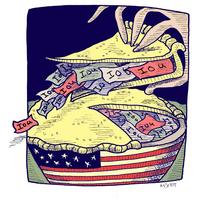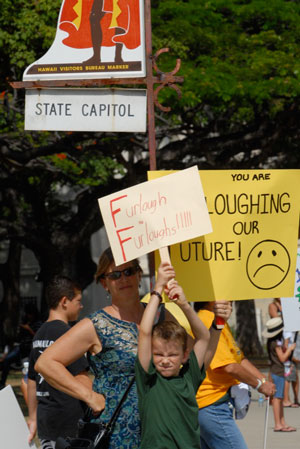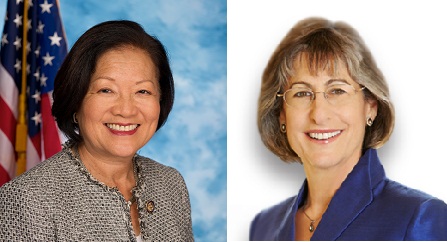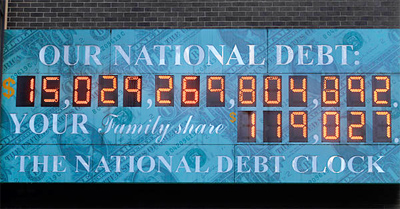Lingle & Hirono: Budget Woes vs School Furloughs
By Nate Gaddis
At their recent debate before the Japanese Chamber of Commerce, Mazie Hirono and Linda Lingle made it clear that they both intend on getting the last word in, at times trading witty but shallow barbs at each other.
Although debates can yield valuably candid exchanges, fully describing an issue in 30 to 60 seconds is a task best suited to caffeinated auctioneers.
There are (sigh) four more debates to go before the general election, but until then we’re taking our time and picking apart some of the more common attacks our would-be senators have been leveling at each other.
So, sit back and sip a beverage while we sift some dirt on your behalf.
Lingle: “Hirono Owns the National Debt”
In a recent press release, former governor Linda Lingle attempted to paint the national debt as a crisis that Rep. Mazie Hirono is in large part responsible for. Her campaign’s statement read:
“Earlier this month, our national debt surpassed $16 trillion for the first time in history. Crippling national debt is the number one threat facing America today because its consequences affect not only our economy, but our national security too.”
Lingle is quick to point out that when Hirono took office in 2007, the national debt was $8.6 trillion and has since nearly doubled.
We’ll get to Hirono’s alleged role in all of this in a moment. But first it’s worth delving into the claim that our national debt is “the number one threat” facing our country.
$16 trillion is certainly a number that would make veins bulge on the forehead of even the most patient creditors. It’s a fat figure indeed, so are the people we owe it to getting a little antsy?
Not really, and for a couple of reasons. For starters, we owe most of that debt to ourselves. Only $5 trillion of that total is owned by foreign institutions (China owns just over $1.1 trillion). The rest is owned domestically by the Social Security Trust, the Federal Reserve, state and municipal governments, and private investors, among other “locals.”
And thanks in part to unrest abroad, our nation’s comparatively safe debt is in high demand. Governments and investors are so eager to lend us money, they’re barely charging us any interest. But compared to everyone else, just how indebted are we?
When measured against the size of a country’s economy (GDP), the US has the 35th worst level of debt in the world. Germany, the economic darling of Europe (and whose prime minister constantly lectures her continent on the need to cut spending) has the 23rd worst level of debt on earth.
That’s not to say we won’t face problems in the future. Medicare is expected to run into major problems by around 2025, unless some combination of budget cuts and revenue increases are put into place.
Back to Hirono’s alleged role. Lingle has tried to tie Hirono to the rise in our national debt, frequently reminding everyone that “Instead of voting based on what’s best for Hawaii, Hirono has voted with her Washington party leaders 96% of the time.”
Simultaneously, she has been critical of Hirono’s role in an estimated $1.2 trillion in automatic budget cuts that may be phased in at the end of this year if the US Congress fails to act. The cuts were used to end a 2011 budget battle that had pushed the US government to the brink of default.

The US Military accounts for the largest slice of our discretionary spending pie. Image courtesy IE University.
Lingle recently criticized the cuts, stating that they will “hurt Hawaii’s economy and severely impact America’s national security. The cuts include … $55 billion in defense spending that will directly impact US Pacific Command in Honolulu.”
This criticism seems counter to part of Lingle’s own plan to reduce the deficit. Her campaign platform states, “I will advocate for annual spending caps on federal discretionary spending which could result in approximately $2 trillion of savings by 2020.”
Military defense spending happens to be the largest single component of federal discretionary spending. When it comes to balancing Hawaii’s well-being with solving our federal budget woes, Lingle seems to be at odds with herself.
Hirono: “Lingle = Furlough Fridays”
In 2009, a group of protestors staged a “sit-in” at Gov. Linda Lingle’s office to protest the “Furlough Fridays” that had been instituted to cope with the state’s budget deficit. Lingle’s refusal to meet with the protestors was followed eventually by arrests and citations, creating a spectacle that would end up cementing the furloughs onto Lingle’s gubernatorial legacy.
The Hirono campaign has been happy to take frequent trips down memory lane, attempting to cast Lingle as the chief architect of the furloughs, and contrasting them with Hirono’s own record of fighting for early childhood education.
Lingle disputes that characterization, blaming the debacle on the state Board of Education.
In the interest of sorting all this out, let’s take a moment to party like it’s 2009.
That year, with the Aloha State still reeling from the effects of the 2008 financial crisis, the Hawaii State Legislature and governor faced a $1 billion budget shortfall.
Approximately 1,000 state employees were laid off, and Lingle ordered three furlough days a month for most remaining state workers. The governor had no authority to implement furloughs for teachers however, and instead she and the state legislature slashed the Department of Education (DOE’s) budget by over $450 million for the years 2009-2011.
Although the department eliminated scores of positions and left many vacancies unfilled, it still came up drastically short of its financial needs. The Board of Education (BOE) and DOE turned to furloughs as a way to trim their budget without resorting to teacher layoffs.
To institute furloughs, the BOE and DOE had to first get the approval of the Hawaii State Teacher’s Association. After bargaining, the union agreed to a total of 34 “Furlough Fridays” over a two-year period. The agreement then went to Lingle, who endorsed it after a four-day period of review.

Furlough Fridays remain a bitter memory for many Hawaii parents. Image courtesy University of Hawaii.
The move proved highly unpopular with parents, many of whom were now stuck trying to care for children who used to be safely ensconced in a classroom. In addition, the state of Hawaii soon found itself with the shortest school year in the nation.
Lingle would later claim that during negotiations, the BOE promised her that the furloughs would be applied to non-instructional days, telling the Associated Press in 2010 that the BOE “double-crossed us.” BOE Chairman Garrett Toguchi flatly denied that assertion.
The nature of the negotiations between Lingle and the BOE comes down to her word against Toguchi’s, and there is no way to verify whether the BOE really promised there would be no furloughs on “non-instructional” days.
But Lingle did sign off on the final proposal, and prior to doing so, issued this statement:
“I appreciate the Department and Board of Education taking the lead in these negotiations…to work toward reaching an agreement with the HSTA that is in the best interest of teachers, our students and the general public.”
If the use of “non-instructional” days was so important, why didn’t the Lingle administration make sure that was spelled out in the proposal, prior to approving it?
It’s unclear. But the DOE, BOE, and HSTA, for their part, seem to have had plenty of “non-instructional” days to work with, at least if the contract ending June 30th, 2009 were any indication. At that time, teachers were allowed six planning/collaboration days, three days for conference leave, five days of personal leave, 18 days of sick leave, 13 official holidays, and 16 vacation days per year.
Although Lingle did sign off on “Furlough Fridays,” the HSTA, BOE, and DOE could have worked together to ensure that furloughs had a lesser impact on students than they did.
Stay Tuned
Both candidates seem to have no shortage of attacks to level at each other, and the race to fill Daniel Akaka’s Senate seat will remain a hot one in the weeks to come.
With the candidates first televised debate scheduled for October 8th on KHON, more mud is sure to follow.












